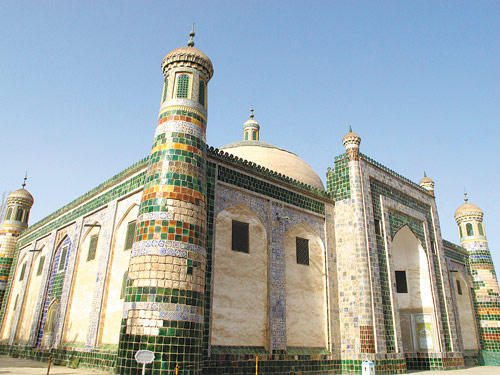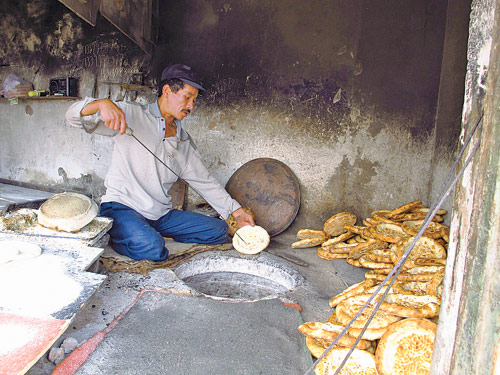Eternal Kashgar
Updated: 2012-11-15 10:42
By Zhang Zixuan (China Daily)
|
||||||||
 |
|
The Tomb of Fragrant Imperial Concubine, built in the Qing Dynasty (1644-1911). |
 |
|
A baker makes the Uygur-style crusty nang. |
At a local family, we ran into preparations for a Uygur wedding. All shoes are left at the entrance in front of the house, which is fully covered by carpeting.
Children and female relatives are crammed into the house, helping with the preparation or just simply playing. Upstairs the bride lies down on the floor to make it easier for the makeup artist who deftly applies makeup to her face. In a few hours, the bridegroom will arrive and pick her up.
Outside, a five-member folk music group has already started performing. Uygur men can no longer sit tight - they get up to dance. Women inside the house are also attracted by the lively sounds and they come out to join the dancing.
They pose with arms and fling back their shoulders. They form a circle, dancing first in one direction and then the other. They also invite new arrivals to join in, turning the yard into a dance floor.
We bid farewell to the hospitable family when they were about to serve Xinjiang-style rice, made with a variety of grains and cooked with mutton, chicken or vegetable.
What lies ahead is the Karakul Lake, about 191 km from Kashgar city. Our car glided through the Gobi Desert, past snow-capped mountains. Small cottages that occasionally appear along the road are completely built from white stone.
Situated 3,600 meters above the sea level, the Karakul Lake is said to be the dressing mirror of the nearby mountains.
The gleaming snow and marshmallow clouds set off the extraordinary blue plateau lake, adding a mysterious and poetic element to the scene.
It only costs 20 yuan (about $3.25) to ride a horse or a camel. The herders guide the animals to the most beautiful spots at the lakeside, giving their customers great photo opportunities in the natural wonderland.

 'Taken 2' grabs movie box office crown
'Taken 2' grabs movie box office crown
 Rihanna's 'Diamonds' tops UK pop chart
Rihanna's 'Diamonds' tops UK pop chart
 Fans get look at vintage Rolling Stones
Fans get look at vintage Rolling Stones
 Celebrities attend Power of Women event
Celebrities attend Power of Women event
 Ang Lee breaks 'every rule' to make unlikely new Life of Pi film
Ang Lee breaks 'every rule' to make unlikely new Life of Pi film
 Rihanna almost thrown out of nightclub
Rihanna almost thrown out of nightclub
 'Dark Knight' wins weekend box office
'Dark Knight' wins weekend box office
 'Total Recall' stars gather in Beverly Hills
'Total Recall' stars gather in Beverly Hills
Most Viewed
Editor's Picks

|

|

|

|

|

|
Today's Top News
Health new priority for quake zone
Xi meets US top military officer
Japan's boats driven out of Diaoyu
China mulls online shopping legislation
Bird flu death toll rises to 22
Putin appoints new ambassador to China
Japanese ships blocked from Diaoyu Islands
Inspired by Guan, more Chinese pick up golf
US Weekly

|

|






